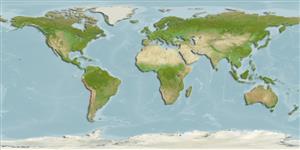>
Scombriformes (Mackerels) >
Scombridae (Mackerels, tunas, bonitos) > Scombrinae
Etymology: Sarda: Latin and Greek, sarda = sardine; name related to the island of Sardinia (Ref. 45335); chiliensis: Named after Chile, South America (Ref. 6885).
More on author: Cuvier.
Issue
Issue on validity of subspecies: subspecies considered as valid in FB, elevated to species rank as Sarda chiliensis (Cuvier, 1832) in Eschmeyer (CofF ver. May 2011: Ref. 86870).
Environment: milieu / climate zone / depth range / distribution range
Ecologie
marien; oceanodroom (Ref. 51243); diepte 0 - 100 m. Subtropical; 60°N - 37°S, 149°W - 70°W (Ref. 168)
Southeast Pacific: northern Peru to Talcahuano, Chile (Ref. 9340). The northern subspecies Sarda chiliensis lineolata occurs from off the coast of Alaska, southward to Cabo San Lucas at the tip of Baja California, and in the Revillagigedo Islands.
Lengte bij maturiteit / Grootte / Gewicht / Leeftijd
Maturity: Lm 47.0 range ? - ? cm
Max length : 102 cm TL mannelijk / geslacht onbekend; (Ref. 9015); max. gepubliceerd gewicht: 11.3 kg (Ref. 168)
Korte beschrijving
Determinatiesleutels | Morfologie | Morfometrie
Dorsale stekels (totaal) : 17 - 19; Anale zachte stralen: 12 - 15; Wervels: 42 - 46. Mouth moderately large. Laminae of olfactory rosette 21 to 39. Interpelvic process small and bifid. Swim bladder absent. Spleen large and prominent in ventral view. Liver with elongate left and right lobes and a short middle lobe. Body completely covered with very small scales posterior to the corselet.
A coastal species that reaches sexual maturity at two years of age (Ref. 9340). Older individuals are encountered farther from the coast as compared to the juveniles (Ref. 9340). Spawning is discontinuous and a female of 3 kg may produce millions of eggs per season (Ref. 9340). Forms schools by size. Feeds on a variety of small schooling fishes, squids and shrimps. This species is important to the recreational hook and line fishery operating from private and party boats, piers and jetties, and from the shore. Also caught with encircling nets (Ref. 9340). Utilized fresh, canned and frozen; eaten broiled and baked (Ref. 9988).
Levenscyclus en paargedrag
Maturiteit | Voortplanting | Paaien | Eieren | Fecunditeit | Larven
Collette, B.B. and C.E. Nauen, 1983. FAO Species Catalogue. Vol. 2. Scombrids of the world. An annotated and illustrated catalogue of tunas, mackerels, bonitos and related species known to date. Rome: FAO. FAO Fish. Synop. 125(2):137 p. (Ref. 168)
Status op de Rode Lijst van het IUCN (Ref. 130435: Version 2024-1)
Gevaar voor de mens
Harmless
Gebruik door de mens
Visserij: van groot commercieel belang; sportvis: ja
Tools
Can't connect to MySQL database fbquizv2. Errorcode: Too many connections
